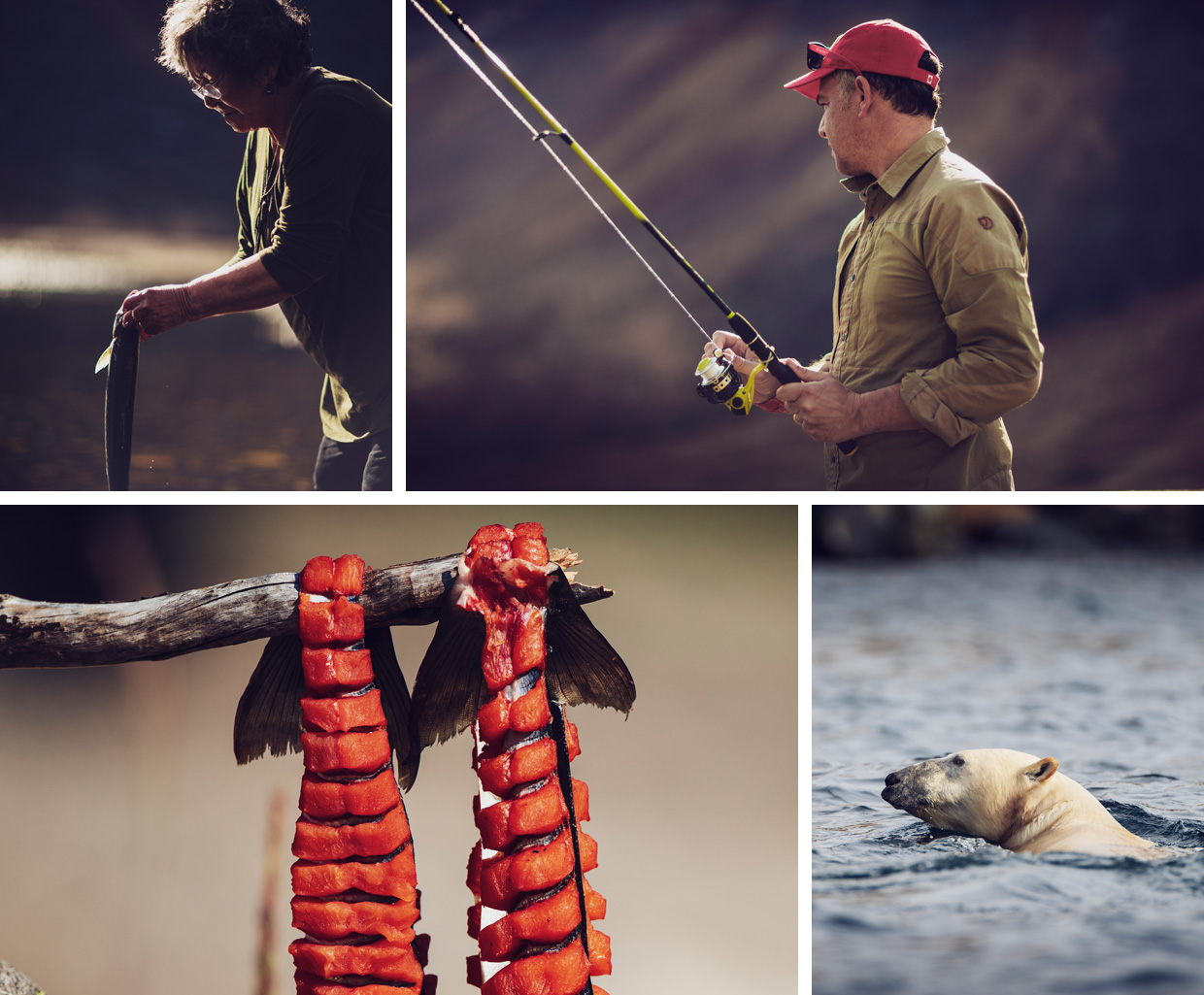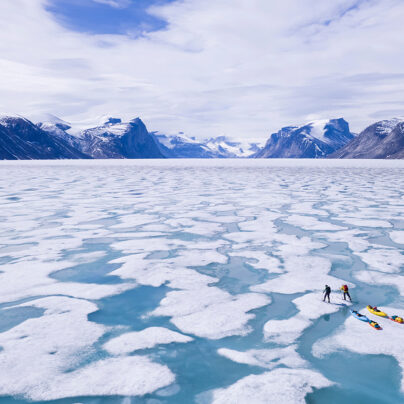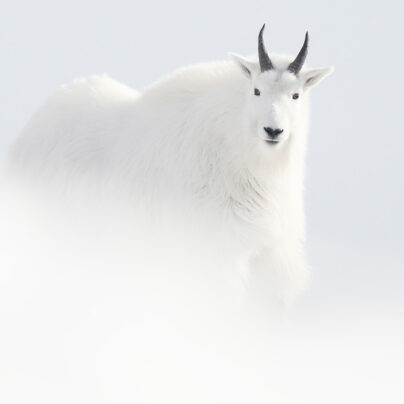Amazing Grace
A Journey Through the Torngat Mountains National Park
Words: Daniel Neilson // Photography: Dave Howells
There are no roads up here, no settlements, just a land populated by polar bears and caribou, black bears and wolves. Its cold seas thrive with minke whales and orcas, char and humpbacks.
‘It’s true. The little people exist. They dress in sealskins and caribou hides, just like us. But when the machinery came, the aeroplanes and the snowmobiles, they fled north. My cousin in Hebron went for a walk, and he came across a dwelling of these little people. He saw a pile of bones and a little person with a bow and arrow.’
‘How big are they?’ I asked Sophie Keelan, a youthful 71-year-old Inuit elder with a long career in healthcare and a cheeky smile.
‘All different sizes. Just like us.’ Noticing perhaps a hint of disbelief on my face, Sophie reiterates: ‘They’re not stories, just true.’
A few days earlier Sophie and other Inuit welcomed us to their homeland on the northern tip of Labrador, Canada. Over the days that followed, we explored this mountainous land by boat and on foot. We saw polar bears and whales, glaciers the size of cruise ships, and ate raw Arctic char on the beach. As the Northern Lights flickered in the evening, we spent time with our hosts, discovering the land through their eyes, hearing stories, playing traditional Inuit games. We also discovered a story so heartbreaking and so forgiving that we wept with our new friends. Though the Torngat Mountains are one of the most dramatic places on Earth, it wasn’t the landscapes that were imprinted in our minds, but the words of Sophie, of Andrew and of Gary, of Boonie and of Maria.
***
The Inuit homeland we’re entering is today protected as the Torngat Mountains National Park, the only Canadian national park run entirely by Inuit staff. It’s 9,700 square kilometres of true wilderness. There are no roads up here, no settlements, just a land populated by polar bears and caribou, black bears and wolves. Its cold seas thrive with minke whales and orcas, char and humpbacks. For the last few years, annual visitor numbers have averaged around 550.



I hop up by plane. From Ottawa to Halifax, a Dash-8 to Goose Bay and, from here, a short take-off and landing Twin Otter. A small group of us, including scientists and photographers, climb the steps into the plane and we take our seats around the cargo. The pilot leans around the cockpit door. ‘Hey, I’m Leonard, y’all strapped in?’ We nod, and we’re off, towards Nain, the northernmost permanent settlement in the province of Newfoundland and Labrador and home to the Nunatsiavut Government. From there, it would be another hour to an old Cold War airstrip at Saglek – long enough for jets, but now abandoned with the exception of Air Borealis flights and charters. By the time we reach Saglek Bay, the mountains have grown bigger, icebergs begin to appear in the sea, and the trees are disappearing. We are now among the oldest rocks in the world, looking down on four billion years of landscape, a place almost as old as the world itself. A helicopter piloted by Kyle Ingram then takes us a couple of minutes to base camp, and the kettle is on.
***
Torngat Mountains Base Camp and Research Station lies just beyond the park’s southern boundary. From the helicopter, it looks like a ramshackle collection of buildings and tents, much like the subarctic research station that it is. It’s a joint venture between Air Borealis and the Nunatsiavut Group of Companies, contracted by the Nunatsiavut Government, a self-governing Inuit regional government. Parks Canada rent space at the base camp to run the park from here.
Our hosts show us to comfortable and warm hard-floored tents and then we go, cuppa in hand, to a ‘bear briefing’. After a safety video that is in equal parts alarming and hilarious, we’re told not to leave the encampment without a bear guard. And indeed, Boonie, Eli and Maria will never leave our side for the week we spend in the Torngat Mountains National Park. As we sit around the fire in the evening, my first Northern Lights above us, we wonder what the Torngats will reveal to us.
***
Willy Fox is the captain of Safe Passage, a boat I swear I last saw as a stunt double in Jaws. He’s a quietly spoken man with a wry sense of humour and a quick laugh. As we sail up Saglek Fjords, 3,000ft of rock rising sharply out of the water, he describes telling signs of climate change affecting the balance of nature. Polar bears are more common in these southern boundaries, while caribou, a staple diet for many Inuit, is becoming dangerously scarce. Such dramatic changes are now measured in a handful of years, not generations.
Circling glaciers, we sway towards our destination: Sallikuluk, or Rose Island, in Saglek Bay. Here we get our first glimpse of a polar bear with a cub, curious, intent, before heading inland to safety. Sallikuluk is a small, treeless island, around 4.5km long and 1.5km wide, but it is a place of incomparable significance to the Inuit people of the area, and one where Sophie’s story begins. She was born here, and she’s brought us back to her homeland – devastatingly, the first of two homes she was forcibly removed from.
‘When I was a child we were nomadic Eskimos, travelling from place to place, season to season, looking for food for survival,’ Sophie tells me. ‘We would be hunting for caribou, foxes, Arctic hare, and the mammals of the seas such as beluga and seals. We had no stores or technology.’
Sallikuluk is a small, treeless island, around 4.5km long and 1.5km wide, but it is a place of incomparable significance to the Inuit people of the area, and one where Sophie’s story begins. She was born here, and she’s brought us back to her homeland – devastatingly, the first of two homes she was forcibly removed from.



It’s an emotional place. Two throat singers, Akinisie Sivuarapik and Sylvia Cloutier, sing a song for the ancestors. Sophie listens with her eyes closed before standing up and placing a rock on the grave.
Sallikuluk has been inhabited for more than 5,000 years and holds a special place in the Inuit story, with families from across the Arctic using it as a base to hunt. It is also a sacred place, and more than 600 people are buried here. Led by Sophie and local Inuk Gary Bakie, superintendent of the park for Parks Canada, we stop at a grave where the remains of 113 people are interred. It’s an emotional place. Two throat singers, Akinisie Sivuarapik and Sylvia Cloutier, sing a song for the ancestors. Sophie listens with her eyes closed before standing up and placing a rock on the grave. This location may not have been their original resting place. The bones here were removed by palaeontologists in 1969 and 1970 and taken to the University of Toronto and then on to the Memorial University of Newfoundland in St. John’s. Gary was instrumental in getting them returned to the homeland.
We walk in single file around the western end of the island; bear guards stand sentry around us. We visit sod houses with whalebone structures and seal intestine windows. Sophie remembers playing in them as a child.
Back on the Safe Passage, we learn more about Sophie’s story. Aged five, her family was moved to Sallikuluk to Hebron, a Moravian mission 40km south. Her parents had no choice; the children had to attend school. It was the end of her nomadic life, but the greatest upheaval came only six years later.
***
From the bell tower of Hebron church, two women play ‘What a Friend We Have in Jesus’ on their trumpets. Some people have travelled by hours on boats to be here for the morning’s service – only the third to have been held here since 1959. Among the attendees are former residents including Gus Semigah, a carpenter who returns every summer to rebuild the church. The church was the centrepiece of the community. But now, like the community around it, the buildings of Hebron are slowly being reclaimed by nature. In a storm in 2018, the Hudson Bay Company’s store collapsed. Its skeletal remains are now warped and bleached.
As funds ran out for the Moravian mission in the 1950s, the 58 families living in Hebron were removed. Sophie remembers: ‘They held the meeting only for the men in the Moravian church, so they couldn’t argue. I think the men were invited because the women have a big voice.’



They split friends and families, many of whom would never see one another again. People were dispersed across communities, to places where they couldn’t hunt or fish – many went hungry – and places where they were outsiders. The social problems from this decision resonate loudly today.
‘We had to pack our personal belongings. The men had to bring their hunting gear and dog teams on their own motorboats. Women and children went on the ship. I remember a brass band playing on the wharf of Hebron. I remember the song they played: “Amazing Grace”. The women were crying. I remember looking back at our community until it was very small and then we couldn’t see it any more.’
In 2019, a plaque was placed by the church apologising for the removals. Next to it is a response from the Inuit of Nutak and Hebron. It ends in the words: ‘We forgive you’.
As we board the boat to make our three-hour return journey to base camp, we hear ‘Amazing Grace’ from two trumpets in the bell tower. The glaciers still shine electric blue in the sun, the distinctive sickle-shaped dorsal fins of minke whales still scoop out of the water, and the evening sun illuminates the rugged beauty of the mountains. Yet their aspect is different from that morning.
As night comes, the faint glow of the Northern Lights shimmers above our campfire. These are the same skies that Sophie was born under, and the same from beneath which she was removed twice from her homeland, the same that we laughed and joked under, played games and shared meals. The same skies where humans have lived, and thrived, for more than 5,000 years. Today, the Torngat Mountains National Park is almost empty of human presence except, perhaps, for the little people.
This story was first published in Sidetracked Volume 16
Written by Daniel Neilson // @danieljneilson
Photography by Dave Howells // @dave_howells_photo
As we board the boat to make our three-hour return journey to base camp, we hear ‘Amazing Grace’ from two trumpets in the bell tower. The glaciers still shine electric blue in the sun, the distinctive sickle-shaped dorsal fins of minke whales still scoop out of the water, and the evening sun illuminates the rugged beauty of the mountains.





